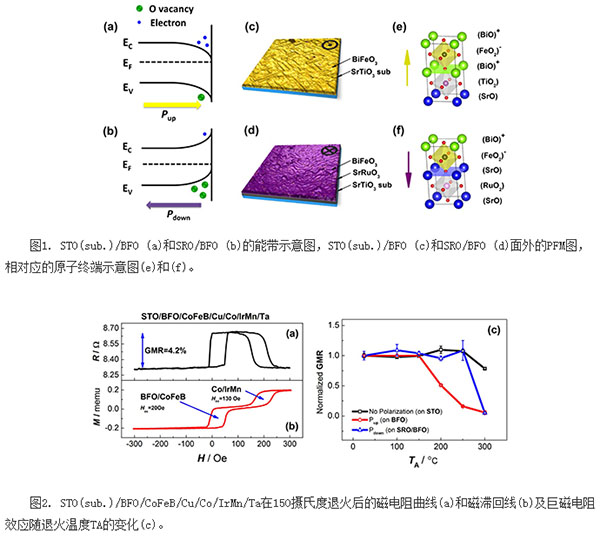The heterostructure consisting of ferromagnetic metals and ferroelectric/multiferroic oxides is promising in the next generation of data nonvolatile, low-power Magnetoelectric Random Access Memories (ME-RAM) Get applied. In such a magnetoelectric memory, the state of magnetization of the ferromagnetic material can be regulated by an electric field applied to a ferroelectric/multiferroic heterostructure memory cell, and its core electrically controlled magnetic operation utilizes a metal/oxide interface. Stress/spin coupling is achieved. For spintronics (GMR giant magnetoresistance effect, TMR tunneling magnetoresistance effect) devices that have been widely used in the industry, the use of annealing processes in the manufacturing process is unavoidable. However, due to the chemical composition incompatibility between the magnetic metal and the ferroelectric/multiferroic oxide, the oxidation reaction at the interface easily occurs during the annealing process, and magnetic metal oxides are formed at the interface, which may destroy the original. The stress/spin coupling at the interface eventually leads to device failure. At present, under the premise of improving the thermal stability of the metal/oxide heterointerface, and at the same time maintaining the functional properties of magnetoelectric control, the development of ferromagnetic and ferroelectric/multiferroic oxide heterojunction device physics is still ongoing. One of the scientific problems to be solved urgently.
Recently, the research team led by Han Xiufeng, a researcher at the Institute of Physics, Chinese Academy of Sciences/Beijing National Laboratory for Condensed Matter Physics, and Wang Junling, a professor at Nanyang Technological University, Singapore, and advanced materials and structural analysis experiments conducted by the Institute of Physics. Laboratory researcher Yu Richeng teamed up to improve the thermal stability of the interface of magnetic metal/oxide heterostructures through an iron electrode method, and clarified a development of this heterostructure material and ME-RAM devices. Key scientific issues. This core physical mechanism for modulating the thermal stability of the interface by the electrodeposition method is the intrinsic coupling of the spontaneous polarization and defects of the ferroelectric oxide.
The work first uses laser pulse deposition technology to prepare BiFeO3 epitaxial films with opposite polarization directions on substrates with different atomic terminations (Fig. 1(c)-(f)). The BFO itself has spontaneous ferroelectric polarization, and the concentration of oxygen vacancies formed on the surface of the BFO is related to the direction of the ferroelectric polarization. The concentration of oxygen vacancies on the surface of the BFO polarized downward is higher than that of the polarized surface (Fig. 1(a) & (b)). On this basis, a GMR of 4.2% (Fig. 2(a) & (b)) and a core structure of Co/Cu/CoFeB were prepared on a BFO epitaxial film with different oxygen vacancy concentrations by magnetron sputtering. Rotary valve. When the ferromagnetic/ferroelectric composite device was annealed at different temperatures, it was found that the thermal stability of the GMR device on the polarization-downward BFO film is about 100 degrees Celsius higher than the polarization upward (Fig. 2(c) ). During the annealing process, the magnetic metal atoms and the oxygen in the ferroelectric oxide film undergo an oxidation reaction to form magnetic metal oxides, thereby reducing the GMR. This conjecture was also verified by macroscopic magnetic moments, X-ray energy dispersive spectroscopy (EDS), and electron energy loss spectra (EELS).
This work has a positive guiding significance for device design and related scientific research of heterojunction composed of ferromagnetic metal and ferroelectric/multiferroic oxide used in ME-RAM. First, a ferromagnetic/multiferroic heterostructure was designed and optimized. This heterostructure can withstand an annealing process at 250 degrees Celsius without degrading its functional properties. Secondly, in order to solve the problem of the failure of the device due to interface oxidation after several times of ferroelectric polarization reversal [J. Heron et al., Nature 516 (2014) 370], this experiment suggests that the use of ferroelectric polarization facing down can reduce the interface. Occurrence of oxidation reaction at this interface. Finally, in related scientific research in the future, doping and other methods can be further used to increase the thermal stability of the heterostructure to above 350 degrees Celsius to achieve the industrial annealing temperature required for the preparation of MgO magnetic tunnel junctions. The relevant research results of this experiment have been published in the "Advanced Materials" magazine [Advanced Materials, Zhang Qinyi, etc., DOI: 10.1002/adma.201502754].
Related research has been supported by the National Natural Science Foundation of China, the Ministry of Science and Technology, and the relevant funds of the Chinese Academy of Sciences.

It is widely used in general ropes, transportation, fishery, petroleum, metallurgy, agriculture and other industries,Important economic value.The twisted rope should be melted and bonded at each end to prevent loosening.
It is widely used in general ropes, transportation, fishery, petroleum, metallurgy, agriculture and other industries,Important economic value.The twisted rope should be melted and bonded at each end to prevent loosening.
t should be noted that the nature Manila Rope will shrink when it is wet with water, so the new rope is usually immersed in water and dried before use, so the shrinkage rate is lower than the shrinkage rate when the rope is never wetted, so you need to consider it when using it. To this point.
Manila Rope
Manila Rope,Manila Hemp,1 Inch Manila Rope,Twisted Manila Rope
Baoying Yiliyuan Rope And Net Co.,Ltd , https://www.ylyropes.com